Microfinance and Tsunami Recovery
Contextualizing Microfinance within the Recovery Efforts After the 2004 Indian Ocean Tsunami.
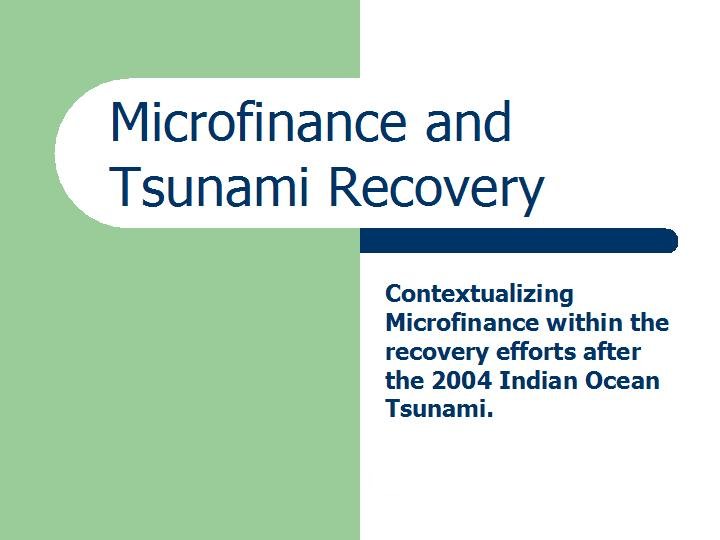
 |
Hari Srinivas |
|
Case Study Series E-101. June 2014
|
This report focuses on the role of microfinance in tsunami recovery, by contextualizing microfinance within thee recovery efforts from the 2004 Indian Ocean Tsunami.
The report is based on a survey of microfinance institutions (MFIs) carried out between June and September 2005, as well as reports from governmental and non-governmental organizations at the national and international levels - including the MFIs themselves.
The concept of microfinance as a viable tool for the poor was tested to its limits during the 2004 tsunami tragedy. With the scale and intensity of the disaster beyond the comprehension of both the MFIs and the communities they served, it was first of all, clear that none had prepared for, or could have ever anticipated, a disaster of such proportions. The lessons learnt from the tragedy has to therefore be looked at by taking this aspect into consideration.
|
|
1. Laying the Context
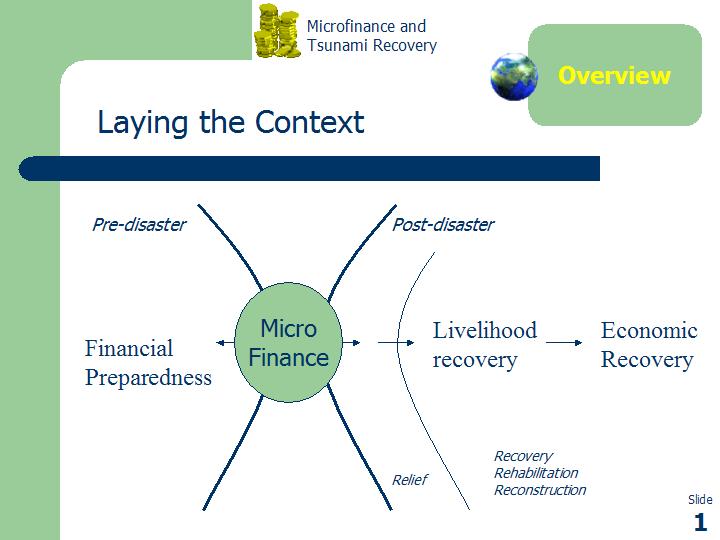
When we look at microfinance from the perspective of disaster management, we an identify issues in both the pre-disaster and post-disaster phases of disaster management.
Most of the pre-disaster issues focuses on financial preparedness, including setting up of contingency funds and micro-insurance. Post-disaster issues (particularly in the recovery and rehabilitation phases) focus on livelihood recovery and economic recovery as a whole.
|
|
2. Why MFIs and Disasters?
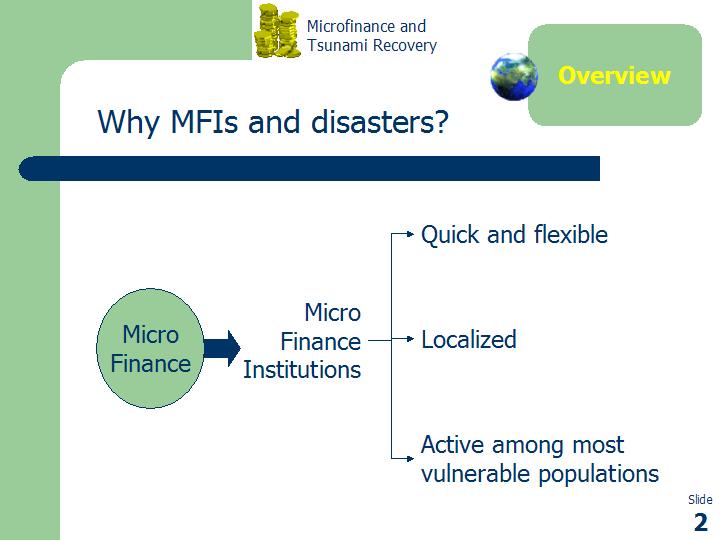
A lot of attention was paid to microfinance as a key tool for communities to recover from the devastating impacts of the tsunami.
The survey of MFIs clearly pointed at three key reasons for the interest that microfinance generated among the international organizations -
- disbursement of microfinance funds to the affected communities was quick and flexible;
- microfinance was highly localized and was closest to the communities, and
- microfinance activities was already in place and being used among the most vulnerable populations in the affected countries.
|
|
3. Why is Microfinance used?
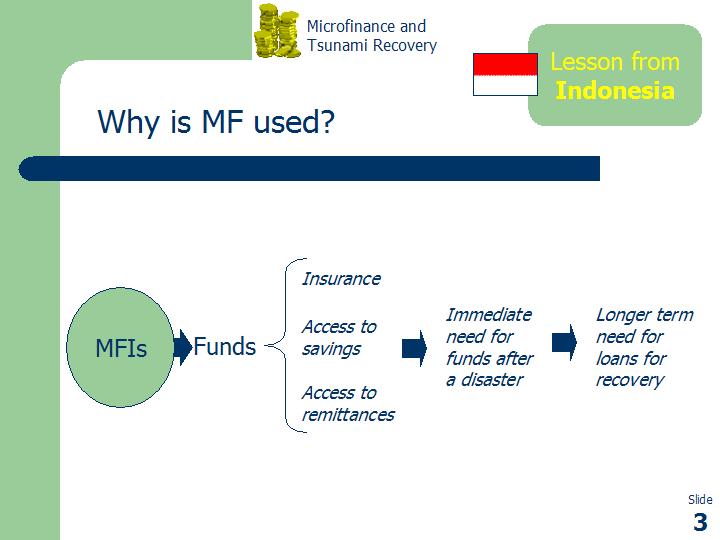
MFIs that were active in the vulnerable communities highlighted the need for earmarking funds for contingencies such as disasters. In Indonesia, MFIs pointed out that affected communities needed - immediate disburcement of micro-insurance,
- quick access to their savings, and
- services to receive remittances from relatives and friends.
These fund requirements came up in two phases - need for funds in the immediate aftermath of a disaster, and longer term need for loans for economic and livelihood recovery.
|
|
4. Microfinance is not ...

The initial flow of massive amounts of relief funds for humanitarian purposes was, in quite a few cases, delivered or disbursed through MFIs, particularly in Indonesia.
MFIs were seen to have extensive support networks in the affected communities, clients and client networks among the most vulnerable communities, and also possess resources and experiences in reaching out to such communities.
But the MFIs made it clear that they should stay within their mandates and client services, and not be involved in relief and charity activities. MFIs also clarified that the microfinance is not the answer to all financial problems and needs of the affected communities - and needs to be only a part of a larger package of financial relief and other services for the communities.
|
|
5. Some bad practices
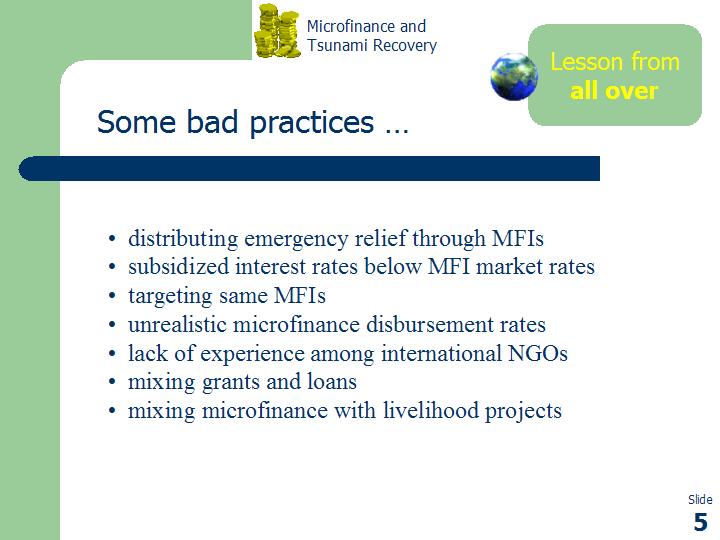
In hindsight, some of the misconceptions of microfinance in the affected countries became clear, key among them being the disbursement of emergency relief through MFIs. Funds provided to MFIs to be loaned to affected communities were subsidized far below market rates.
Many international donors targeted the same MFIs creating an unbalanced distribution of funds among the affected areas. The pressure on MFIs to quickly disburse funds was also quite unrealistic, considering their capacities and reach.
Lack of understanding of microfinance, of its potentials and limitations among international NGOs was also citied as an area that needed improvement. They also cited the problems they faced as a result of mixing grants and loans, and of mixing microfinance with the development and implementation of livelihood projects.
|
|
6. Changing Financial Needs
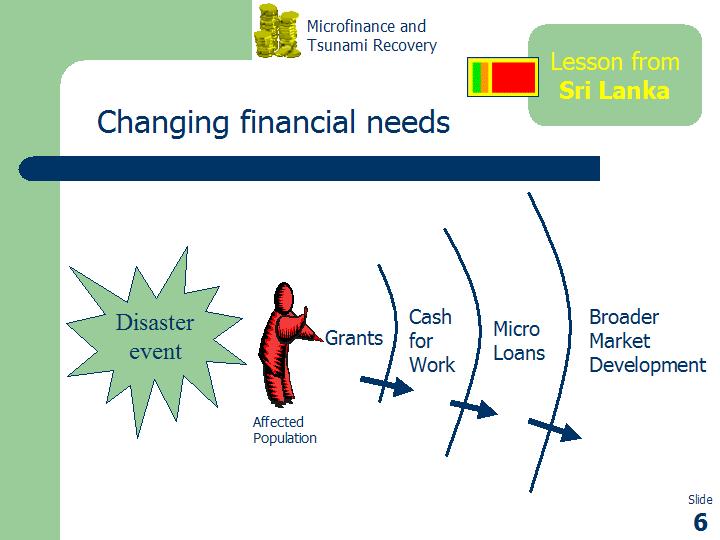
Experiences of MFIs in Sri Lanka among the tsunami affected populations showed how the financial needs of the communities changed as time passed. In the immediate aftermath of the tsunami, there was a clear need for outright grants that would enable the households to survive the first few weeks.
This was followed by opportunities in the medium-term to earn money through cash-for-work initiatives and for micro-loans for livelihood recovery.
The MFIs also highlighted the need for longer-term efforts to continue in a sustained manner, aiming towards broader market development.
|
|
7. Cross-linking fund resources

MFIs that were active in the tsunami-affected areas in South-east and South-west India emphasized the need for microfinance funds specifically for indivisual household recovery processes to rebuild household income generating assets.
They also emphasized the need for these funds to be clearly dovertailed into funds for larger processes of recovery, rehabilitation and reconstruction, to restore physical, social and economic infrastructure.
|
|
8. Developing the support systems
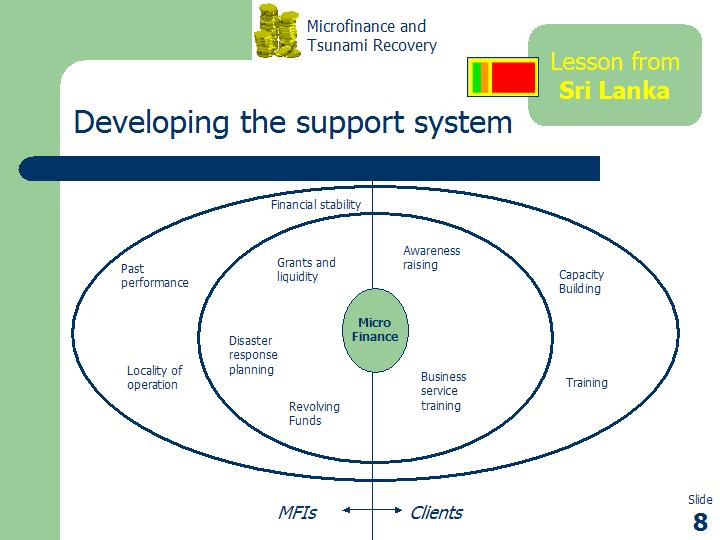
While microfinance is essentially 'micro' in scale, Sri Lankan MFIs came to realize that there was a clear need to develop a support system within which microfinance activities could be positioned.
For MFIs, this support system includes issues such as grants/liquidity, disaster response planning and revolving. In the longer/broader term, it also includes issues such as financial stability, past performance (for trust building), locality of operation etc.
For the clients of MFIs, the support system includes issues such as awareness raising and business service training, followed by capacity building and other training activities in the longer/broader term.
|
|
9. Post-tsunami future plans
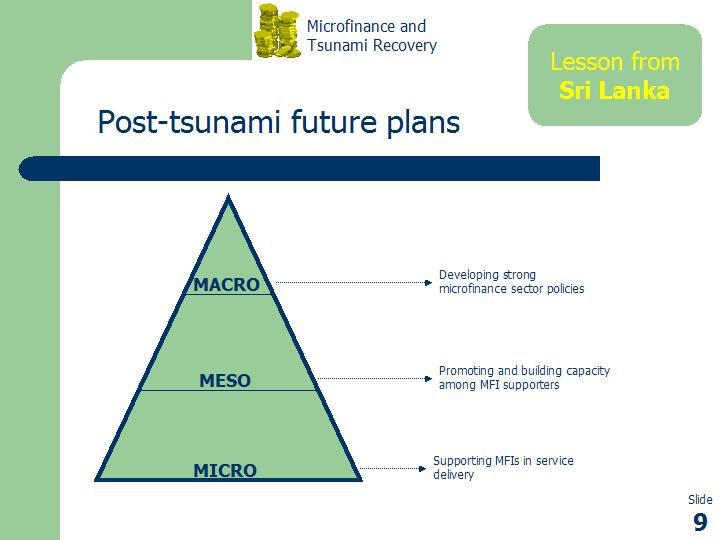
Sri Lankan MFIs emphasized the need for activities to be carried out at the micro, meso and macro levels in order to strengthen MFIs ' response during disaster events.
- At the mirco level, there was a need for supporting MFIs in service delivery;
- At the meso level, there was a need to promote and build capacity among MFI supporters; and
- At the macro level, there was a need to develop strong microfinance sector policies.
|
|
10. Capacity, capacity, capacity

One cross-cutting and recurring issue emphasized by most MFIs in Sri Lanka, Indonesia, India and Thailand focused on the need for capacity building.
In the medium term, MFIs expressed the need for comprehensive in-country training, access to expert advice and support, recording good practices and policy dialogue with governments and other agencies in financial preparedness for disasyters.
In the longer term, MFIs expressed the need for more train-the-trainer initiatives, training on disaster management for MFI staff members, curriculum development and integration of financial aspects (specifically microfinance) ain disaster coordination and planning.
|
|
11. More capacity ...
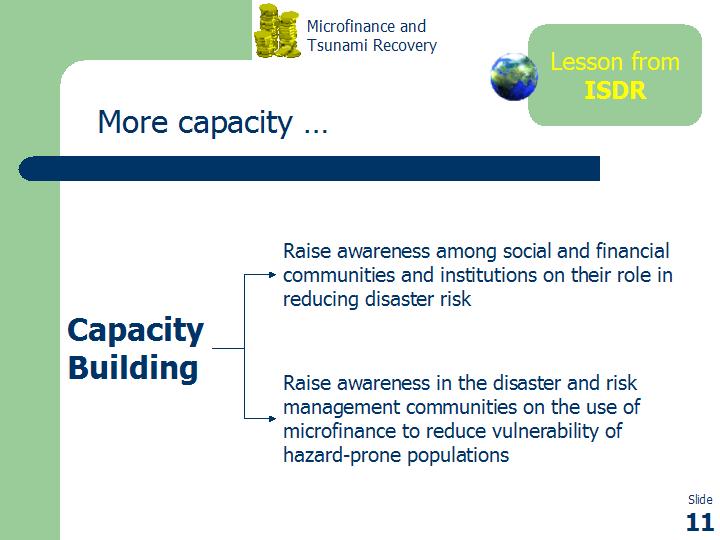
These viewpoints of MFIs in affected regions resonate well with capacity building issues highlighted by the International Strategy for Disaster Reduction (ISDR).
ISDR has emphasized the specific needs to (a) Raise awareness among social and financial communities and institutions on their role in reducing disaster risk, and (b) Raise awareness in the disaster and risk management communities on the use of microfinance to reduce vulnerability of hazard-prone populations
|
|
12. MFIs looking at themselves
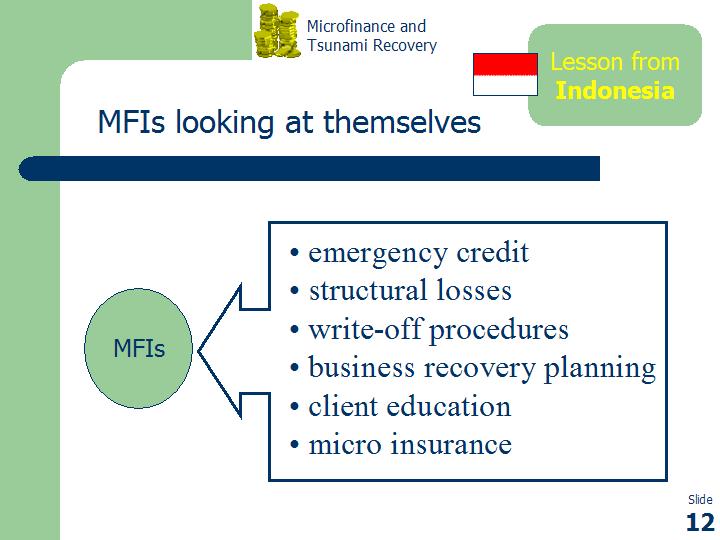
MFIs were also asked what steps they would like to take temselves, to prepare for disaster events. Some of the issues highlighted by Indonesian MFIs reflect the needs of the sector in other countries as well - to allocate funds for emergency credit and contingencies to prepare for and absorb structural losses themselves.
They also emphasized related issues such as write-off procedures, business recovery planning, client education and micro insurance, that required more detailed planning and preperation.
|
|
13. A reminder from WCDR ...
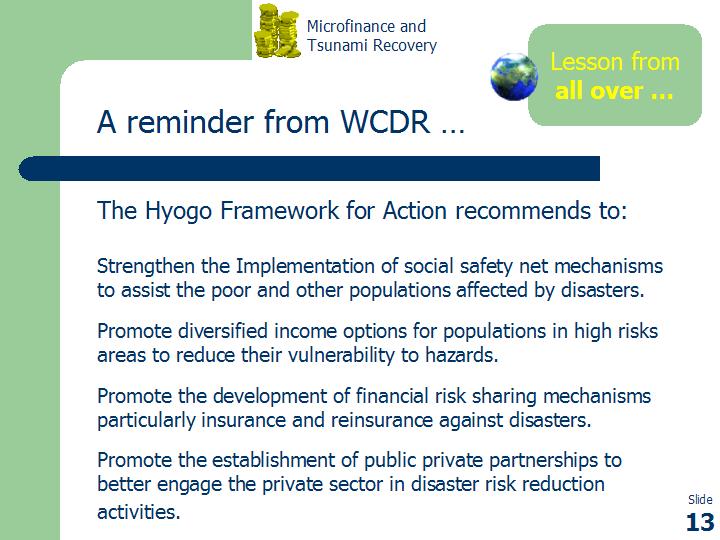
As a concluding note, it may be useful for us to be reminded of the recommendations made by the Hyogo Framework of Action, which was adopted at the World Conference on Disaster Reduction (WCDR) that took place in Kobe Japan in January 2005.
Specifically related to financial issues, it calls for strengthening the Implementation of social safety net mechanisms to assist the poor and other populations affected by disasters, and promoting diversified income options for populations in high risks areas to reduce their vulnerability to hazards.
It also calls for promoting the development of financial risk sharing mechanisms particularly insurance and reinsurance against disasters, and establishing public private partnerships to better engage the private sector in disaster risk reduction activities.
|
|
|